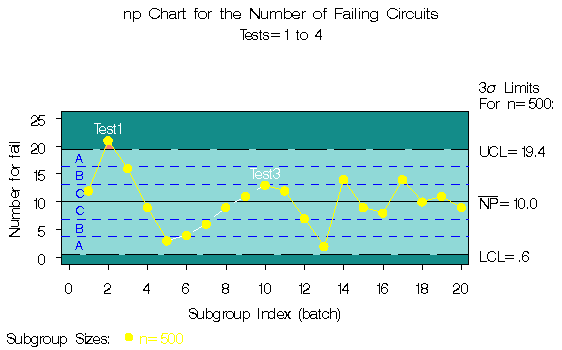Chapter Contents
Previous
Next
|
Chapter Contents |
Previous |
Next |
| NPCHART Statement |
| See SHWNP2 in the SAS/QC Sample Library |
This example
shows how you can apply tests for special causes
to make np charts more sensitive to special causes of variation.
The following statements create a SAS data set named
CIRCUIT3, which contains the number of failing circuits
for 20 batches from the circuit manufacturing process
introduced in the "Creating np Charts from Count Data" section:
data circuit3;
input batch fail @@;
datalines;
1 12 2 21 3 16 4 9
5 3 6 4 7 6 8 9
9 11 10 13 11 12 12 7
13 2 14 14 15 9 16 8
17 14 18 10 19 11 20 9
;
The following
statements create the np chart, apply
several tests to the chart, and tabulate the results:
title1'np Chart for the Number of Failing Circuits';
title2 'Tests=1 to 4';
symbol v=dot c=yellow;
proc shewhart data=circuit3;
npchart fail*batch / subgroupn = 500
tests = 1 to 4
ltests = 20
zonelabels
tabletest
tablelegend
cframe = vibg
cinfill = vlibg
coutfill = salmon
cconnect = yellow
czones = blue
ctests = cxfefefe;
run;
The ZONELABELS option displays zone lines and zone labels on the chart. The zones are used to define the tests. The LTESTS= option specifies the line type used to connect the points in a pattern for a test that is signaled.
Output 37.1.1 and Output 37.1.2 indicate that Test 1 is positive at batch 2 and Test 3 is positive at batch 10.
Output 37.1.1: Tests for Special Causes Displayed on np Chart

|
|
Chapter Contents |
Previous |
Next |
Top |
Copyright © 1999 by SAS Institute Inc., Cary, NC, USA. All rights reserved.